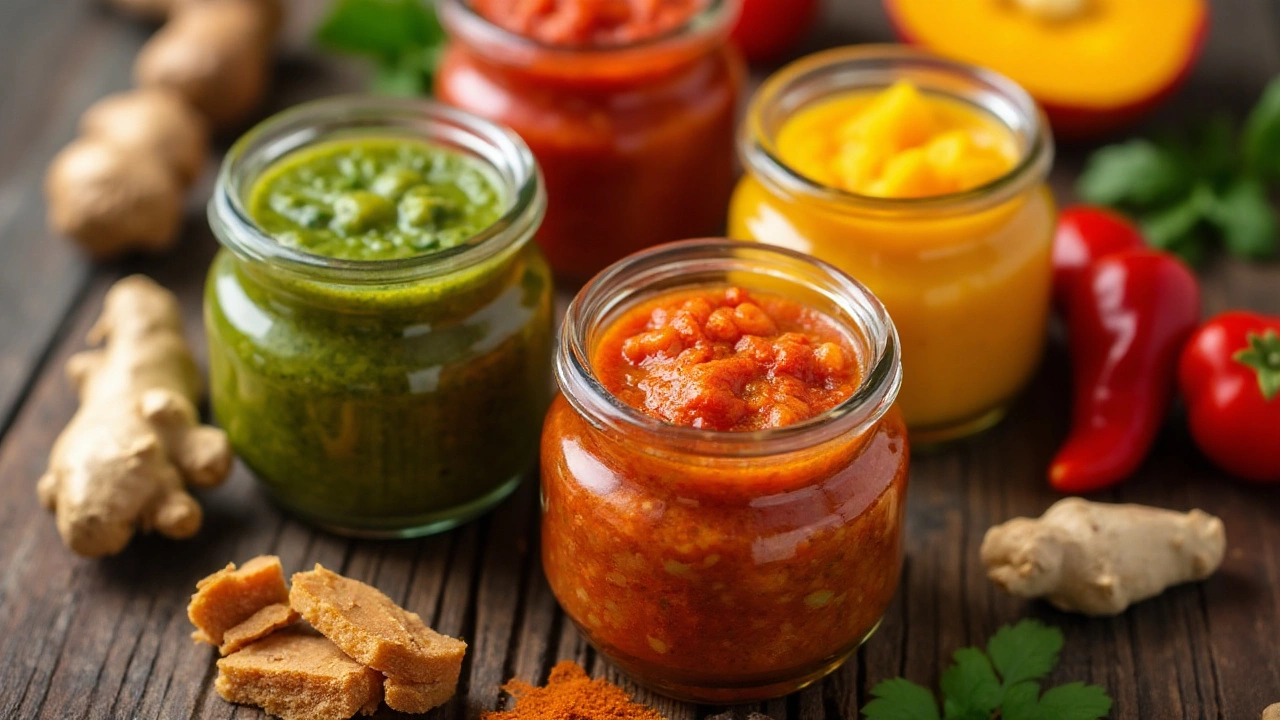Chutney has long been a cherished companion to various dishes, known for its ability to elevate the simplest of meals. This versatile condiment comes in many flavors and textures, crafted from a blend of fruits, vegetables, herbs, and spices. But beyond its taste, there’s an intriguing question many ponder: Is chutney actually good for you?
Delving into this query requires examining the spectrum of chutney ingredients, as they range from nutrition-packed herbs to the occasional sugar-heavy preparation. Each ingredient in your chutney holds the potential for health benefits, yet also poses considerations to keep in mind. Whether you’re savoring a spicy mango chutney or a cooling mint version, understanding what lies beneath the surface can help you make informed culinary choices.
Join us as we explore the health implications of chutney, from its most beneficial aspects to possible drawbacks. Discover tips on creating your own healthier versions and how to seamlessly integrate this delicious condiment into a nourishing diet. The world of chutney is ready to be unraveled, offering insights and flavors that go beyond the ordinary.
- The Nutritional Power of Chutney Ingredients
- Potential Health Benefits of Chutney
- Possible Drawbacks and Considerations
- Tips for Making Healthier Chutney
- Incorporating Chutney into a Balanced Diet
The Nutritional Power of Chutney Ingredients
When you dip into a serving of chutney, you might not immediately think about the vitamins and minerals packed within. This delightful condiment can be both tasty and nutritious, largely owing to its diverse array of ingredients. Unlike more processed condiments, chutney often uses whole fruits, vegetables, and spices that brim with beneficial nutrients. Mangoes, for instance, are a popular chutney base, providing a rich source of Vitamin C and A, essential for bolstering the immune system and promoting healthy skin. Another common component is mint, often included for its fresh flavor, but it also packs antioxidants and can aid in digestion.
Then there's coriander, a staple in many chutney recipes, offering fiber, manganese, and magnesium, which collectively support heart health. And let's not forget the spices – ginger and garlic, which are more than just flavor enhancers. Ginger is known for its anti-inflammatory properties, while garlic is famed for its potential to lower blood pressure and cholesterol levels. It’s the combination of these ingredients that infuses chutney with its nutritional power, making it more than just a tasty accompaniment. Writing about these ingredients, one could say, "Each spoonful of chutney can be a small treasure trove of health."
A fascinating way to appreciate chutney's nutritional prowess is to delve into its diverse varieties. Sweet chutneys might incorporate sugar, but fruits like dates or tamarind can serve as healthier substitutes, adding natural sweetness along with iron and potassium. If you're opting for a more spicy kick, green chutneys harness the power of chilies, which contain capsaicin, a compound known for speeding up metabolism and providing relief from pain. Then there are tomato-based chutneys; though different from ketchup, they capitalize on the lycopene-rich tomatoes that are renowned for their role in reducing heart disease risk. It’s these choices and combinations that truly make chutney shine in the world of condiments.
According to a food and nutrition expert, "Chutney offers a combination of flavors and nutrients that are often overlooked in our daily diets, making it a delicious way to incorporate more health benefits into our meals."
The combination of these fresh, whole ingredients places chutney in a unique category among condiments. Not all chutneys are created equal, though. While some can be loaded with salt or sugar, understanding portion sizes and choosing combinations rooted in beneficial ingredients can mean a big difference in their impact on health. It’s crucial to note the simplicity of preparation; homemade chutney allows for control over the ingredients, ensuring maximum flavor and nutritional benefits. As you explore different kinds of chutneys, you'll find that they not only bring a delightful taste to the table but also serve as a tool for enriching your diet with essential nutrients and compounds.
Potential Health Benefits of Chutney
Chutney, a lively and flavorful condiment, brings more to the table than just zest and warmth. While each recipe varies, the core ingredients often hold noteworthy nutritional profiles that can potentially bestow several health advantages. When sourced from fresh fruits, vegetables, and aromatic spices, chutneys can be a treasure trove of vitamins and minerals crucial for our well-being. Chutney ingredients such as coriander, mint, or tamarind pack a punch of antioxidants, helping to combat oxidative stress and reduce inflammation in the body.
The high levels of Vitamin C in fruit-based chutneys, like mango or citrus chutneys, contribute to immune system support and skin health. Vitamin C is a vital nutrient that boosts the body’s natural defenses against pathogens and facilitates collagen production, essential for maintaining skin elasticity and resilience. This means regular consumption of Vitamin C-rich chutney can aid in keeping illnesses at bay while glowing your skin from within.
Another remarkable aspect of chutney lies in its digestive properties. Many traditional spice blends include ginger, cumin, and asafoetida, all known to ease digestive discomforts and enhance gut health. Ginger, in particular, is celebrated for its ability to soothe nausea and improve overall digestion. Cumin supports enzymatic activity in the gut, ensuring smoother food breakdown and nutrient absorption. According to a report by the Journal of Food Compositions and Analysis, certain spices in chutneys also harbor natural antiseptic properties, which can promote a healthier digestive system.
The renowned culinary author Madhur Jaffrey once mused, "In its myriad forms, chutney turns an ordinary meal into a feast while inviting the spices' benefits onto our plates." This resonates with chutney’s ability to not only heighten flavor but deliver nutritional perks as well.
For those keeping an eye on their heart health, chutneys can offer some encouraging benefits too. Ingredients like garlic and turmeric are often incorporated into savory chutney mixes, known for their positive effects on cardiovascular wellbeing. Garlic is praised for its cholesterol-lowering potential, while turmeric’s curcumin compound has been extensively studied for its anti-inflammatory and antioxidant activities, which are protective to heart tissues. These natural components help modulate cholesterol levels, support circulation, and manage blood pressure, which are all vital for a healthy heart.
The abundance of dietary fiber in vegetable-based chutneys such as tomato or beetroot also plays a pivotal role in supporting digestion and satiety. Fiber not only promotes regularity and aids in toxin elimination but also helps curb hunger by providing a sense of fullness prolonging energy. Working these chutneys into your diet can ensure you're receiving these advantages without deprivation.

Possible Drawbacks and Considerations
As delightful as chutney can be, it's important to delve into the possible pitfalls that come with this flavorful condiment. One of the main concerns is the presence of sugar, which is often included to balance the tartness of vinegar or the freshness of fruits like mango. High sugar content can be problematic for people monitoring their sugar intake, such as those with diabetes or those trying to maintain a healthy weight. The sugar in chutney can sometimes sneak up on you, so it's best to be mindful when indulging.
Additionally, some store-bought chutneys can be surprisingly high in salt. Sodium acts as a preservative and flavor enhancer but consuming too much has its own health implications. Excessive salt intake is known to contribute to increased blood pressure, which in turn raises the risk of heart disease and stroke. It’s always wise to check the labels of pre-packaged chutneys to see just how much sodium is present. If the information isn’t available, making chutney at home allows you to control these elements much more effectively.
Another factor to consider is the use of preservatives in commercial chutneys. Preservatives extend shelf life, but some individuals might have sensitivities to these additives, which can manifest as allergic reactions or digestive discomfort. Such reactions aren't typical for everyone, but if you've experienced issues with preservatives before, it might be worth looking for natural or homemade alternatives.
An aspect often overlooked is the calorie content of chutney. While most homemade chutneys are relatively low in calories, the ones with added sugars and oils can shoot up in caloric density pretty quickly. For those tracking caloric intake, it's helpful to be aware of this when piling on chutney as a side or a topping. Keeping to moderate portions ensures you enjoy its rich flavors without having to worry about overloading on calories.
Some chutneys can also contain allergens like nuts or mustard, depending on their recipe. This means that when serving to a group, especially if allergies are a concern, it's crucial to know what’s inside the chutney. Allergies to any of these ingredients can lead to severe reactions, so always advise those partaking to check the ingredients, especially if you didn't prepare the chutney yourself.
According to a report by Healthline, “For people with specific dietary concerns, like reducing sugar or sodium, evaluating the nutritional content of chutney can make all the difference.”
To navigate these potential drawbacks, consider keeping an eye out for chutneys labeled as low-sugar or reduced-salt. Making your own chutney at home is another viable option. By doing so, not only do you have control over what goes in, but you can also experiment with healthier substitutions, such as swapping sugar with honey or using fresh produce to avoid preservatives. Creating your own chutney ensures you're indulging in a version tailored to personal health needs and dietary preferences, making it both a delicious and mindful choice at the same time.
Tips for Making Healthier Chutney
Whipping up a batch of homemade chutney can be a delightful culinary adventure, offering the chance to customize flavors and nutritional elements. To make a healthier chutney that's both delicious and nutritious, you should start by selecting fresh, organic fruits and vegetables. Choosing ingredients at their peak ripeness not only enhances the taste but also maximizes the nutrient content, providing a vibrant dose of vitamins and minerals. Mangoes, tomatoes, coconut, and mint are classic choices brimming with antioxidants and natural sweetness that can elevate your condiment while keeping refined sugars at bay.
Another essential aspect is keeping an eye on the amount of sugar added—and if possible, it’s best to skip refined sugars entirely. You can achieve sweetness using natural alternatives like honey, agave nectar, or even dates, which provide added nutritional benefits. The art of balancing flavors in chutney involves not just sweet, but also sour, tangy, and spicy notes. Good options for acidity include apple cider vinegar or freshly squeezed lemon juice; both add zest without loading up on unwanted calories. Adding an array of spices such as cumin, coriander, and ginger not only enhances taste but also delivers anti-inflammatory properties, supporting heart health.
It’s crucial to moderate the amount of salt in your chutney recipe as well. Excessive salt can dampen the health benefits, so consider using Himalayan pink salt or sea salt sparingly. Incorporating fiber-rich ingredients such as whole fruits, skins intact, or adding chia seeds can improve digestion while maintaining a satisfying consistency. Cooking methods can also impact healthiness; opting to simmer ingredients slowly over low heat preserves essential nutrients and flavors more effectively than high-heat techniques.
According to a study published in the Nutrition Journal, "Opting for natural seasonings and avoiding processed additions can substantially impact the health profile of homemade condiments."
Experimenting with herbs like basil, coriander, or parsley revitalizes your chutney with potent phytonutrients. Don't hesitate to personalize your blend by adjusting ingredient quantities based on seasonal availability, which not only promotes sustainability but keeps your food tasting fresh. Creating a healthier chutney isn't just about taking steps to limit less desirable elements, but about exploring varied ingredients filled with potential. So next time you settle into the kitchen to craft your favorite condiment, remember these tips to make chutney that complements both flavor and well-being.

Incorporating Chutney into a Balanced Diet
In the culinary world, chutney has carved out a niche as a delightful accent to both everyday and gourmet meals. When seeking to integrate this flavorful condiment into a balanced diet, it’s crucial to consider its diverse blend of ingredients and flavors. For many food enthusiasts, chutney doesn’t just serve its role as a tangy sidekick; it becomes a central ingredient, adding depth and character to dishes. While exploring ways to merge it seamlessly with a nutrient-rich eating plan, it helps to understand the pivotal role chutney ingredients can play. A chutney packed with tomatoes, for instance, could enrich your meal with the antioxidants found in lycopene. Choosing a chutney with robust spices might not only enhance taste but also bring anti-inflammatory benefits, depending on the herbs used. The secret is in selecting varieties that support your nutritional goals.
Perhaps you’re fond of meals that offer a harmony of flavors and nutrients. Consider using chutney as a low-calorie dressing on salads, where its spices and texture can replace more caloric-laden options. In sandwiches, replace high-fat spreads with chutney, lending both moisture and zesty punches of flavor. An interesting data point to highlight here is that opting for herb-based chutneys can significantly reduce unhealthy fat intake by an average of 25% when compared to cream-based condiments. This simple swap gives dishes a fresh kick while keeping them in line with dietary goals. A point often overlooked is the ability of chutneys to enhance the flavor profile of grilled meats and proteins, without necessarily adding excess sugars or unhealthy fats, as demonstrated in various culinary studies.
There are many traditional ways to marry chutney with your meals, going beyond just a side serving. For the food adventurer, creating homemade chutneys allows for control over sugar and salt content, crucial for those watching their intake. You'll find that a fruit-based chutney recipe can double as a naturally sweet spread for whole-grain toast or pancakes, turning breakfast into a tantalizing treat that aligns with daily nutritional targets. It's about switching up routines and improvising with ingredients, much like home chefs who’ve found that using chutney as a marinade can not only tenderize protein sources but add culinary excitement as well.
As noted by culinary expert Alice Waters, "The versatility of chutney lies in its bold capacity to complement and transform ingredients, creating balance in every bite."For those seeking to maintain health while enjoying the spice of life chutney offers, it’s wise to stay vigilant about portion sizes, especially with sweeter variants. Using small amounts on the side can encourage flavor without overwhelming the dietary balance. By treating chutney as more than just a condiment, you'll discover its ability to reinvent familiar foods and lead meals into the realm of gastronomic delight.
If you approach your meals with creativity and a sense of balance, you’ll find that adding chutney to everyday diets doesn’t require sacrifice. With chutney, the opportunities to nourish and enjoy are endless, revealing new dimensions of flavor while adhering to wholesome lifestyle choices.
